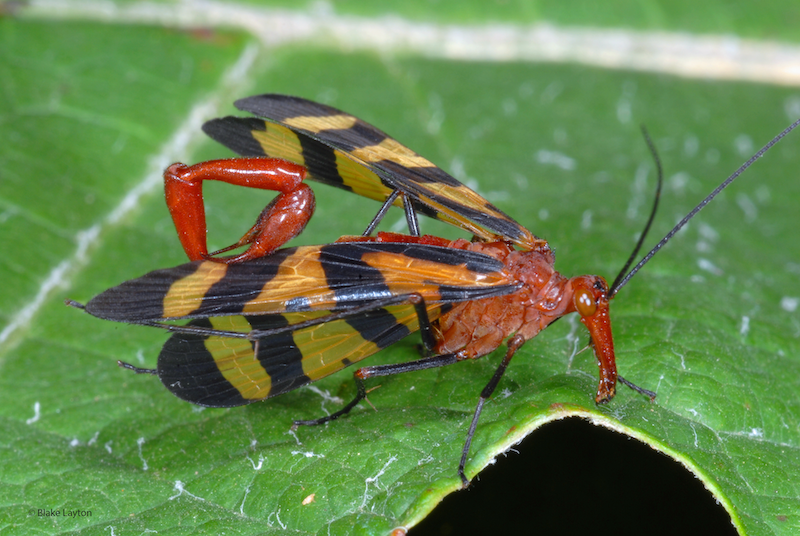Scorpionfly, Vol. 8, No. 31
Panorpa nuptalis
Order: Mecoptera
Family: Panorpidae
Scorpionflies are neither scorpions nor flies. These strange-looking insects belong to one of the lesser-known insect orders, Mecoptera. There is no doubt where they got their name, but scorpionflies are harmless. Look closely at that structure at the end of the abdomen and you can see it is made for clasping, not stinging. Only males have this structure, which they use to clasp the female when mating. Why such a long face? That’s just the way scorpionflies are made. But do not be misled; scorpionflies have chewing mouthparts, not sucking. There are mandibles at the end of that snout. The male in this photo is about one inch long.
Scorpionflies are also unusual in other ways. In moths and many other insects, it is the female that uses pheromones to attract males, but in some species of scorpionflies, males release pheromones to attract females. They also entice females by offering a “nuptial gift,” such as a dead insect, which has the added benefit of providing the female with additional nutrition for egg production. Several species of scorpionflies occur in the Southeast, but only the nuptial scorpionfly, shown here, has an unofficial common name.
Although they occur throughout the state, scorpionflies are relatively uncommon and rarely seen. Adults are most often found in the understory of wooded areas or along the edges of woods. Little is known about the feeding habits of immature scorpionflies, but adults feed on dead insects, decaying plants, and even dead animals. A friend from graduate school had a knack for providing scorpionflies for insect collections. This was a useful skill because number of orders was a big part of the grade, and Mecoptera is a difficult order to find. An avid squirrel hunter, he finally revealed that he sometimes found scorpionflies resting on the skins of squirrels he left in the woods from a hunt the previous day.
Where else might you look to find a scorpionfly? On a postage stamp. In 1998 the US Postal Service produced a sheet of 33 cent stamps featuring twenty of the more colorful insects in the country. Despite its relative obscurity, the nuptial scorpionfly was one of the featured insects.
Blake Layton, Extension Entomology Specialist, Mississippi State University Extension Service.
The information given here is for educational purposes only. Always read and follow current label directions. Specific commercial products are mentioned as examples only and reference to specific products or trade names is made with the understanding that no discrimination is intended to other products that may also be suitable and appropriately labeled.
Mississippi State University is an equal opportunity institution.
Bug’s Eye View is now on Facebook. Join the Bug's Eye View Facebook group here.


